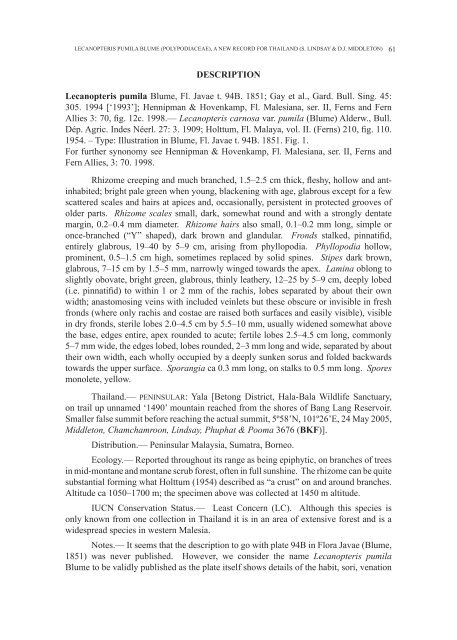You also want an ePaper? Increase the reach of your titles
YUMPU automatically turns print PDFs into web optimized ePapers that Google loves.
LECANOPTERIS PUMILA BLUME (POLYPODIACEAE), A NEW RECORD FOR <strong>THAI</strong>LAND (S. LINDSAY & D.J. MIDDLETON) 61<br />
DESCRIPTION<br />
Lecanopteris pumila Blume, Fl. Javae t. 94B. 1851; Gay et al., Gard. Bull. Sing. 45:<br />
305. 1994 [‘1993’]; Hennipman & Hovenkamp, Fl. Malesiana, ser. II, Ferns and Fern<br />
Allies 3: 70, fig. 12c. 1998.— Lecanopteris carnosa var. pumila (Blume) Alderw., Bull.<br />
Dép. Agric. Indes Néerl. 27: 3. 1909; Holttum, Fl. Malaya, vol. II. (Ferns) 210, fig. 110.<br />
1954. – Type: Illustration in Blume, Fl. Javae t. 94B. 1851. Fig. 1.<br />
For further synonomy see Hennipman & Hovenkamp, Fl. Malesiana, ser. II, Ferns and<br />
Fern Allies, 3: 70. 1998.<br />
Rhizome creeping and much branched, 1.5–2.5 cm thick, fleshy, hollow and antinhabited;<br />
bright pale green when young, blackening with age, glabrous except for a few<br />
scattered scales and hairs at apices and, occasionally, persistent in protected grooves of<br />
older parts. Rhizome scales small, dark, somewhat round and with a strongly dentate<br />
margin, 0.2–0.4 mm diameter. Rhizome hairs also small, 0.1–0.2 mm long, simple or<br />
once-branched (“Y” shaped), dark brown and glandular. Fronds stalked, pinnatifid,<br />
entirely glabrous, 19–40 by 5–9 cm, arising from phyllopodia. Phyllopodia hollow,<br />
prominent, 0.5–1.5 cm high, sometimes replaced by solid spines. Stipes dark brown,<br />
glabrous, 7–15 cm by 1.5–5 mm, narrowly winged towards the apex. Lamina oblong to<br />
slightly obovate, bright green, glabrous, thinly leathery, 12–25 by 5–9 cm, deeply lobed<br />
(i.e. pinnatifid) to within 1 or 2 mm of the rachis, lobes separated by about their own<br />
width; anastomosing veins with included veinlets but these obscure or invisible in fresh<br />
fronds (where only rachis and costae are raised both surfaces and easily visible), visible<br />
in dry fronds, sterile lobes 2.0–4.5 cm by 5.5–10 mm, usually widened somewhat above<br />
the base, edges entire, apex rounded to acute; fertile lobes 2.5–4.5 cm long, commonly<br />
5–7 mm wide, the edges lobed, lobes rounded, 2–3 mm long and wide, separated by about<br />
their own width, each wholly occupied by a deeply sunken sorus and folded backwards<br />
towards the upper surface. Sporangia ca 0.3 mm long, on stalks to 0.5 mm long. Spores<br />
monolete, yellow.<br />
Thailand.— PENINSULAR: Yala [Betong District, Hala-Bala Wildlife Sanctuary,<br />
on trail up unnamed ‘1490’ mountain reached from the shores of Bang Lang Reservoir.<br />
Smaller false summit before reaching the actual summit, 5º58’N, 101º26’E, 24 May 2005,<br />
Middleton, Chamchamroon, Lindsay, Phuphat & Pooma 3676 (BKF)].<br />
Distribution.— Peninsular Malaysia, Sumatra, Borneo.<br />
Ecology.— Reported throughout its range as being epiphytic, on branches of trees<br />
in mid-montane and montane scrub forest, often in full sunshine. The rhizome can be quite<br />
substantial forming what Holttum (1954) described as “a crust” on and around branches.<br />
Altitude ca 1050–1700 m; the specimen above was collected at 1450 m altitude.<br />
IUCN Conservation Status.— Least Concern (LC). Although this species is<br />
only known from one collection in Thailand it is in an area of extensive forest and is a<br />
widespread species in western Malesia.<br />
Notes.— It seems that the description to go with plate 94B in Flora Javae (Blume,<br />
1851) was never published. However, we consider the name Lecanopteris pumila<br />
Blume to be validly published as the plate itself shows details of the habit, sori, venation
















